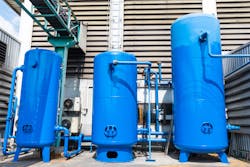I was visiting the pilot plant to evaluate a new evaporator technology for a client. However, something else caught my eye as I walked around the facility. All of the pumps were driven by compressed air, using so-called “air motors.” I had heard of pneumatic drives, but I had never seen one before, so I asked the supervisor about them. Being the “energy guy,” I asked the obvious question, “How efficient are they?”
“They are great!” he replied. “Wonderfully efficient.”
With hindsight, my question probably wasn’t fair — or at least, my interpretation of his answer wasn’t. The supervisor’s job was to keep the plant running smoothly. The pneumatic pumps were convenient, safe and reliable. They met his criteria, so from his perspective they were “efficient.” However, I tend to look at things from the perspective of energy use. I had trouble understanding how they could be “efficient” in that sense, so I did some research.
By far the most widespread use for compressed air in refineries and chemical plants is for driving valve actuators. The other major uses I have seen are in pneumatic conveying and packaging machines. Pneumatic tools of various types are very common in discrete manufacturing, such as car manufacturing; familiar uses in everyday life also exist, such as jackhammers, pneumatic jacks and air compressors to inflate tires.
In some cases, individual items of pneumatic equipment may be energy-efficient when viewed in isolation. However, to evaluate them properly we must consider the whole pneumatic system, not just a single piece of equipment. To do this, we use the concept of cascaded efficiency I discussed in an earlier article (“Take a Closer Look at Cascaded Efficiency,” March 2020.)
Let’s return to the air motors on the pumps in the pilot plant I mentioned earlier, and consider the system supporting them. We need compressors to produce the compressed air. Electric motors drive the compressors. The compressed air is then distributed and fed to the air motors to deliver power to the pump shafts. Each stage in this operation incurs losses, and therefore has an efficiency of less than 100%. But it gets worse. Overproducing compressed air, and venting the excess, often controls the operating pressure in compressed air systems. That vent represents a waste of compressor power. In addition, most compressed air systems lose large amounts of air through leaks. Furthermore, air pressure losses always exist; these diminish the deliverable power per unit of air flow. Line friction or partially blocked filters and, sometimes, pressure regulators used to control the pressure in different parts of the system can cause the air pressure losses. The following cascade calculation, with indicative values for each inefficiency, provides a rough indication of the compounded effect of these losses.
System efficiency = 0.95(electric motor) * 0.7(compressor) * [1-0.1](10% control vent) *[1-0.1](10% leaks) * 0.8 (impact of system pressure loss) * 0.7(air motor) = 0.30, or 30%
Using electric motors to drive the pilot plant’s pumps directly could have delivered the same amount of shaft power at the electric motor efficiency of 95%. Opting for the air motors instead increases the electricity requirement by a factor of 95/30, or nearly 3.2. Some published examples indicate even lower efficiencies for the compressed air option — see, for example, Alan Rossiter & Beth Jones, ‘Energy Management and Efficiency for the Process Industries,’ AIChE/John Wiley & Sons, Inc., Hoboken, New Jersey, 2015, Chapter 22.
Some opportunities exist to improve compressed air system efficiency. For example, installing better control systems, reducing system pressure, and bolstering maintenance to reduce leaks and minimize pressure drops across filters can all contribute to operating savings. Initial selection of more efficient equipment (compressors, air motors, etc.), or upgrading existing equipment, can also raise efficiency.
Pneumatic devices often do provide safe, convenient, reliable service; for many applications they are the right choice. However, compressed air is a very inefficient means of power delivery; in many cases, the best option is to replace pneumatic equipment with electric equivalents, or alternative technologies.
About the Author

Alan Rossiter
Energy Columnist
Alan Rossiter is a former contributor for Chemical Processing's Energy Saver column. He has more than 35 years of experience in process engineering and management, including eight years in plant technical support, design and research with Imperial Chemical Industries (ICI, United Kingdom) and nine years in energy efficiency and waste minimization consulting with Linnhoff March, before starting his own business. In 2019 he joined the University of Houston as Executive Director, External Relations for UH Energy. He is a chartered engineer (U.K.) and a registered professional engineer in the state of Texas. His latest book, Energy Management and Efficiency for the Process Industries, coauthored with Beth Jones, was published by John Wiley & Sons in 2015. He is a Fellow of the American Institute of Chemical Engineers and a Past Chair of the South Texas Section of the AIChE.
